LEGL 212 - Employment Law - Sexual Harassment in Canada
VerifiedAdded on 2023/05/28
|13
|2902
|444
Essay
AI Summary
This essay provides a comprehensive overview of sexual harassment within the context of Canadian employment law. It begins with a clear thesis statement addressing the importance of addressing sexual harassment in the workplace and raising awareness among employees. The legal framework is established by referencing the Canadian Labour Code, the Ontario Human Rights Code, and the Occupational Health and Safety Act (OHSA), outlining employer responsibilities such as creating harassment policies, developing prevention programs, and conducting investigations. The essay then compares and contrasts the perspectives of employers and employees, highlighting the new legislation, employer liability, and employee rights. The essay emphasizes the importance of training, reporting, and providing a safe work environment. The essay concludes with an opinion favoring employees and a summary of key points, reinforcing the need for awareness and the implementation of effective policies and programs to prevent sexual harassment, ultimately fostering a more respectful and productive workplace. The essay is supported by references to relevant legal cases and scholarly articles.
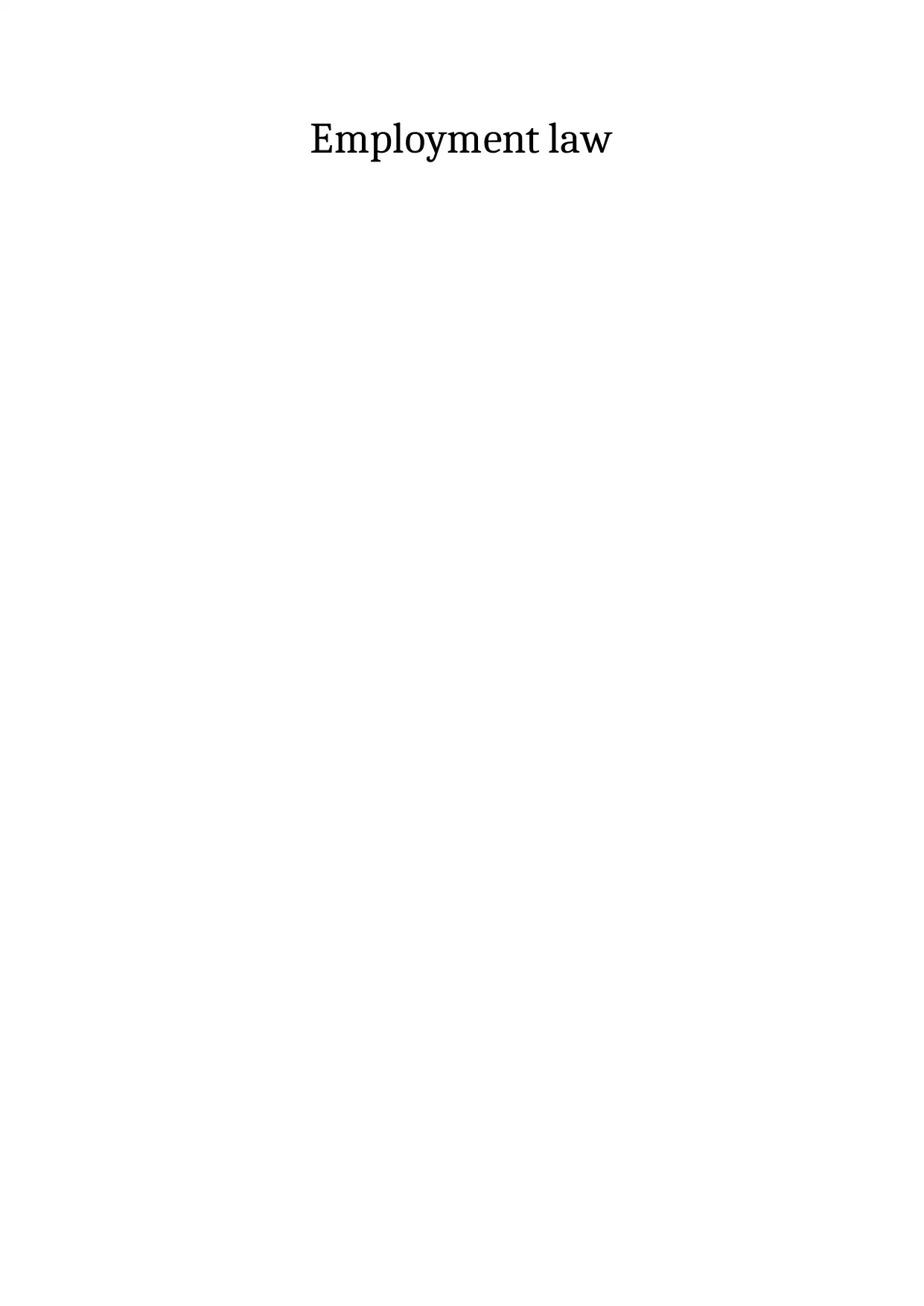
Employment law
Paraphrase This Document
Need a fresh take? Get an instant paraphrase of this document with our AI Paraphraser
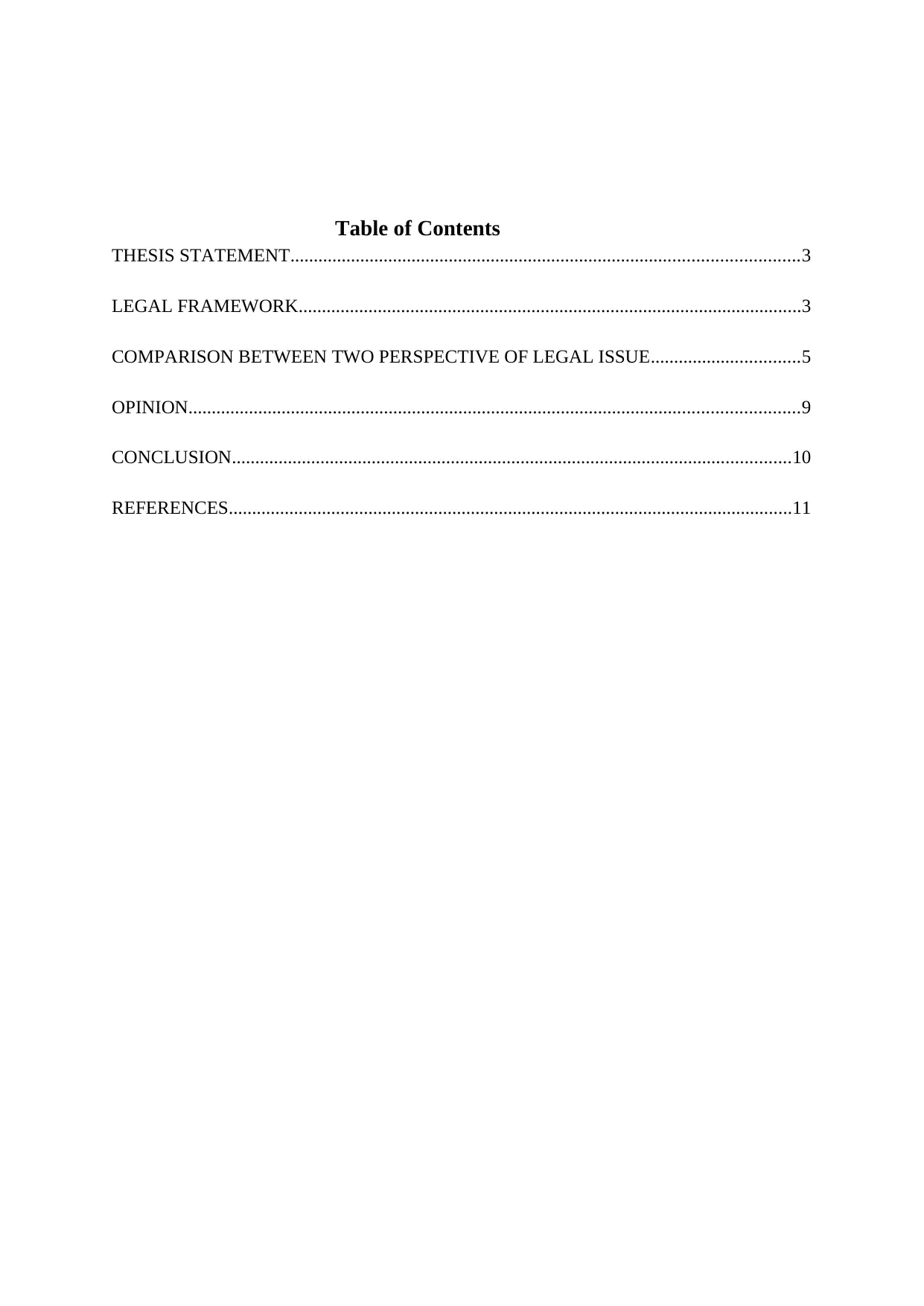
Table of Contents
THESIS STATEMENT.............................................................................................................3
LEGAL FRAMEWORK............................................................................................................3
COMPARISON BETWEEN TWO PERSPECTIVE OF LEGAL ISSUE................................5
OPINION...................................................................................................................................9
CONCLUSION........................................................................................................................10
REFERENCES.........................................................................................................................11
THESIS STATEMENT.............................................................................................................3
LEGAL FRAMEWORK............................................................................................................3
COMPARISON BETWEEN TWO PERSPECTIVE OF LEGAL ISSUE................................5
OPINION...................................................................................................................................9
CONCLUSION........................................................................................................................10
REFERENCES.........................................................................................................................11

List of Figures
Figure 1 Code of Conduct........................................................................................................11
Figure 1 Code of Conduct........................................................................................................11
⊘ This is a preview!⊘
Do you want full access?
Subscribe today to unlock all pages.

Trusted by 1+ million students worldwide
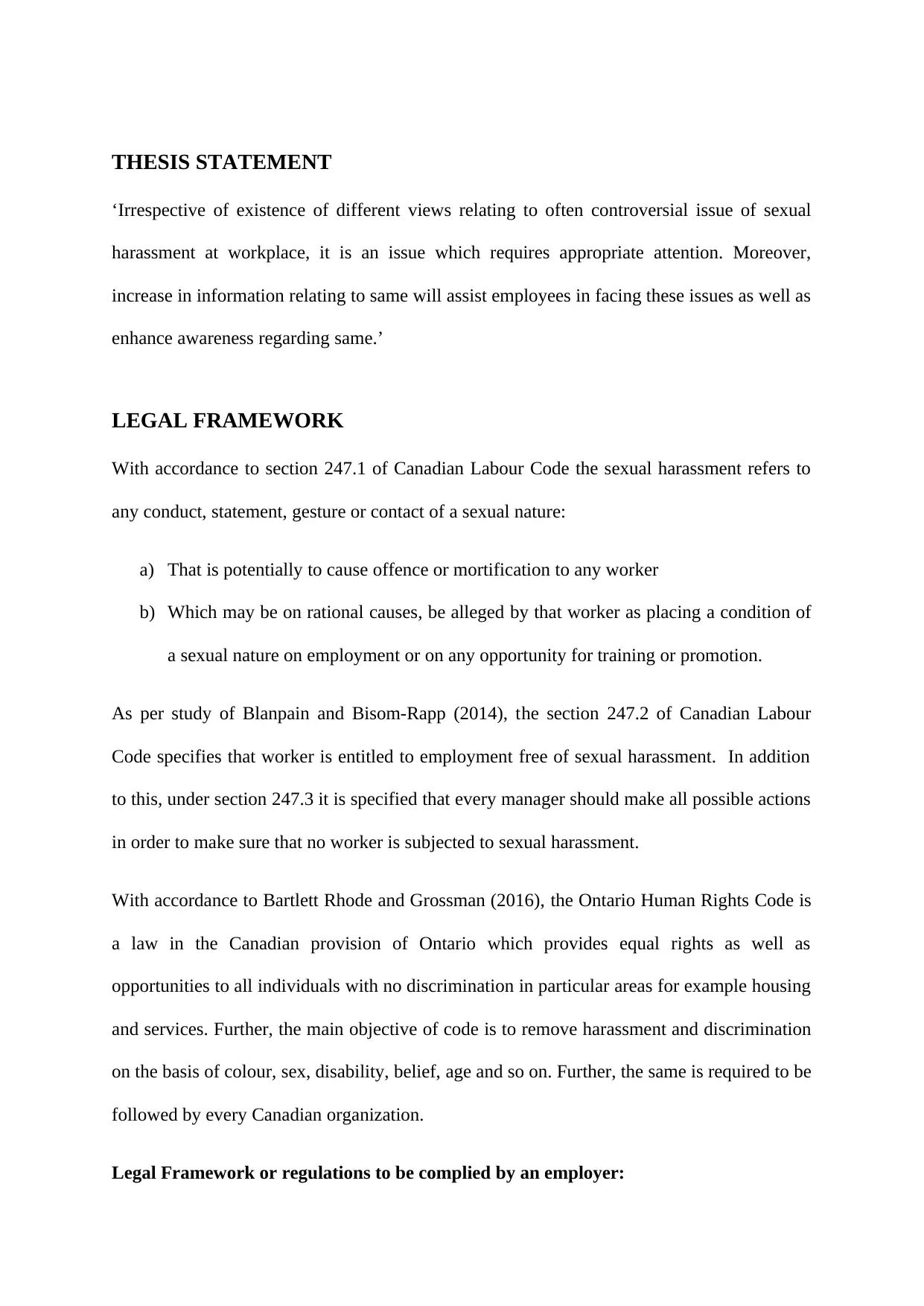
THESIS STATEMENT
‘Irrespective of existence of different views relating to often controversial issue of sexual
harassment at workplace, it is an issue which requires appropriate attention. Moreover,
increase in information relating to same will assist employees in facing these issues as well as
enhance awareness regarding same.’
LEGAL FRAMEWORK
With accordance to section 247.1 of Canadian Labour Code the sexual harassment refers to
any conduct, statement, gesture or contact of a sexual nature:
a) That is potentially to cause offence or mortification to any worker
b) Which may be on rational causes, be alleged by that worker as placing a condition of
a sexual nature on employment or on any opportunity for training or promotion.
As per study of Blanpain and Bisom-Rapp (2014), the section 247.2 of Canadian Labour
Code specifies that worker is entitled to employment free of sexual harassment. In addition
to this, under section 247.3 it is specified that every manager should make all possible actions
in order to make sure that no worker is subjected to sexual harassment.
With accordance to Bartlett Rhode and Grossman (2016), the Ontario Human Rights Code is
a law in the Canadian provision of Ontario which provides equal rights as well as
opportunities to all individuals with no discrimination in particular areas for example housing
and services. Further, the main objective of code is to remove harassment and discrimination
on the basis of colour, sex, disability, belief, age and so on. Further, the same is required to be
followed by every Canadian organization.
Legal Framework or regulations to be complied by an employer:
‘Irrespective of existence of different views relating to often controversial issue of sexual
harassment at workplace, it is an issue which requires appropriate attention. Moreover,
increase in information relating to same will assist employees in facing these issues as well as
enhance awareness regarding same.’
LEGAL FRAMEWORK
With accordance to section 247.1 of Canadian Labour Code the sexual harassment refers to
any conduct, statement, gesture or contact of a sexual nature:
a) That is potentially to cause offence or mortification to any worker
b) Which may be on rational causes, be alleged by that worker as placing a condition of
a sexual nature on employment or on any opportunity for training or promotion.
As per study of Blanpain and Bisom-Rapp (2014), the section 247.2 of Canadian Labour
Code specifies that worker is entitled to employment free of sexual harassment. In addition
to this, under section 247.3 it is specified that every manager should make all possible actions
in order to make sure that no worker is subjected to sexual harassment.
With accordance to Bartlett Rhode and Grossman (2016), the Ontario Human Rights Code is
a law in the Canadian provision of Ontario which provides equal rights as well as
opportunities to all individuals with no discrimination in particular areas for example housing
and services. Further, the main objective of code is to remove harassment and discrimination
on the basis of colour, sex, disability, belief, age and so on. Further, the same is required to be
followed by every Canadian organization.
Legal Framework or regulations to be complied by an employer:
Paraphrase This Document
Need a fresh take? Get an instant paraphrase of this document with our AI Paraphraser
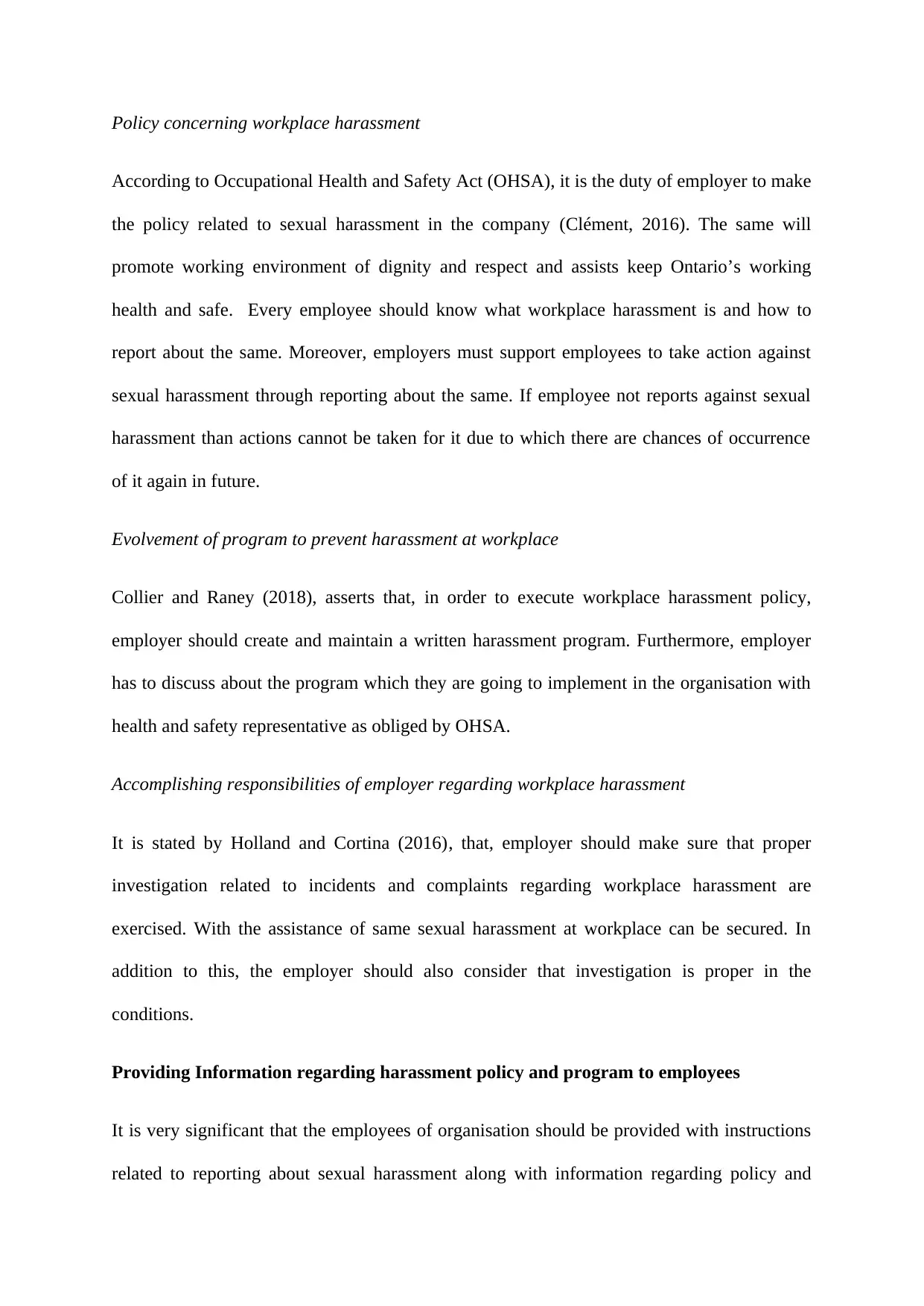
Policy concerning workplace harassment
According to Occupational Health and Safety Act (OHSA), it is the duty of employer to make
the policy related to sexual harassment in the company (Clément, 2016). The same will
promote working environment of dignity and respect and assists keep Ontario’s working
health and safe. Every employee should know what workplace harassment is and how to
report about the same. Moreover, employers must support employees to take action against
sexual harassment through reporting about the same. If employee not reports against sexual
harassment than actions cannot be taken for it due to which there are chances of occurrence
of it again in future.
Evolvement of program to prevent harassment at workplace
Collier and Raney (2018), asserts that, in order to execute workplace harassment policy,
employer should create and maintain a written harassment program. Furthermore, employer
has to discuss about the program which they are going to implement in the organisation with
health and safety representative as obliged by OHSA.
Accomplishing responsibilities of employer regarding workplace harassment
It is stated by Holland and Cortina (2016), that, employer should make sure that proper
investigation related to incidents and complaints regarding workplace harassment are
exercised. With the assistance of same sexual harassment at workplace can be secured. In
addition to this, the employer should also consider that investigation is proper in the
conditions.
Providing Information regarding harassment policy and program to employees
It is very significant that the employees of organisation should be provided with instructions
related to reporting about sexual harassment along with information regarding policy and
According to Occupational Health and Safety Act (OHSA), it is the duty of employer to make
the policy related to sexual harassment in the company (Clément, 2016). The same will
promote working environment of dignity and respect and assists keep Ontario’s working
health and safe. Every employee should know what workplace harassment is and how to
report about the same. Moreover, employers must support employees to take action against
sexual harassment through reporting about the same. If employee not reports against sexual
harassment than actions cannot be taken for it due to which there are chances of occurrence
of it again in future.
Evolvement of program to prevent harassment at workplace
Collier and Raney (2018), asserts that, in order to execute workplace harassment policy,
employer should create and maintain a written harassment program. Furthermore, employer
has to discuss about the program which they are going to implement in the organisation with
health and safety representative as obliged by OHSA.
Accomplishing responsibilities of employer regarding workplace harassment
It is stated by Holland and Cortina (2016), that, employer should make sure that proper
investigation related to incidents and complaints regarding workplace harassment are
exercised. With the assistance of same sexual harassment at workplace can be secured. In
addition to this, the employer should also consider that investigation is proper in the
conditions.
Providing Information regarding harassment policy and program to employees
It is very significant that the employees of organisation should be provided with instructions
related to reporting about sexual harassment along with information regarding policy and
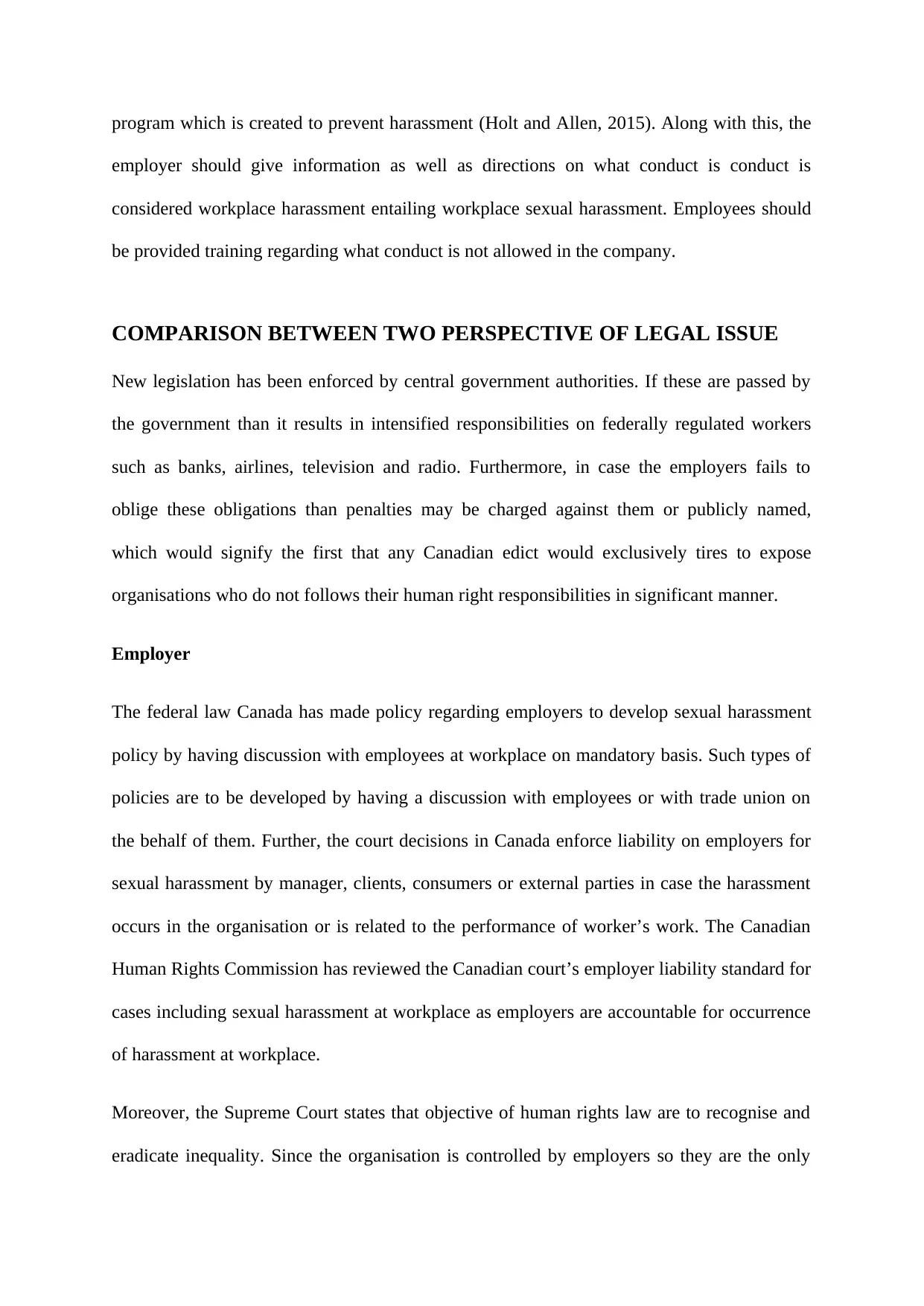
program which is created to prevent harassment (Holt and Allen, 2015). Along with this, the
employer should give information as well as directions on what conduct is conduct is
considered workplace harassment entailing workplace sexual harassment. Employees should
be provided training regarding what conduct is not allowed in the company.
COMPARISON BETWEEN TWO PERSPECTIVE OF LEGAL ISSUE
New legislation has been enforced by central government authorities. If these are passed by
the government than it results in intensified responsibilities on federally regulated workers
such as banks, airlines, television and radio. Furthermore, in case the employers fails to
oblige these obligations than penalties may be charged against them or publicly named,
which would signify the first that any Canadian edict would exclusively tires to expose
organisations who do not follows their human right responsibilities in significant manner.
Employer
The federal law Canada has made policy regarding employers to develop sexual harassment
policy by having discussion with employees at workplace on mandatory basis. Such types of
policies are to be developed by having a discussion with employees or with trade union on
the behalf of them. Further, the court decisions in Canada enforce liability on employers for
sexual harassment by manager, clients, consumers or external parties in case the harassment
occurs in the organisation or is related to the performance of worker’s work. The Canadian
Human Rights Commission has reviewed the Canadian court’s employer liability standard for
cases including sexual harassment at workplace as employers are accountable for occurrence
of harassment at workplace.
Moreover, the Supreme Court states that objective of human rights law are to recognise and
eradicate inequality. Since the organisation is controlled by employers so they are the only
employer should give information as well as directions on what conduct is conduct is
considered workplace harassment entailing workplace sexual harassment. Employees should
be provided training regarding what conduct is not allowed in the company.
COMPARISON BETWEEN TWO PERSPECTIVE OF LEGAL ISSUE
New legislation has been enforced by central government authorities. If these are passed by
the government than it results in intensified responsibilities on federally regulated workers
such as banks, airlines, television and radio. Furthermore, in case the employers fails to
oblige these obligations than penalties may be charged against them or publicly named,
which would signify the first that any Canadian edict would exclusively tires to expose
organisations who do not follows their human right responsibilities in significant manner.
Employer
The federal law Canada has made policy regarding employers to develop sexual harassment
policy by having discussion with employees at workplace on mandatory basis. Such types of
policies are to be developed by having a discussion with employees or with trade union on
the behalf of them. Further, the court decisions in Canada enforce liability on employers for
sexual harassment by manager, clients, consumers or external parties in case the harassment
occurs in the organisation or is related to the performance of worker’s work. The Canadian
Human Rights Commission has reviewed the Canadian court’s employer liability standard for
cases including sexual harassment at workplace as employers are accountable for occurrence
of harassment at workplace.
Moreover, the Supreme Court states that objective of human rights law are to recognise and
eradicate inequality. Since the organisation is controlled by employers so they are the only
⊘ This is a preview!⊘
Do you want full access?
Subscribe today to unlock all pages.

Trusted by 1+ million students worldwide
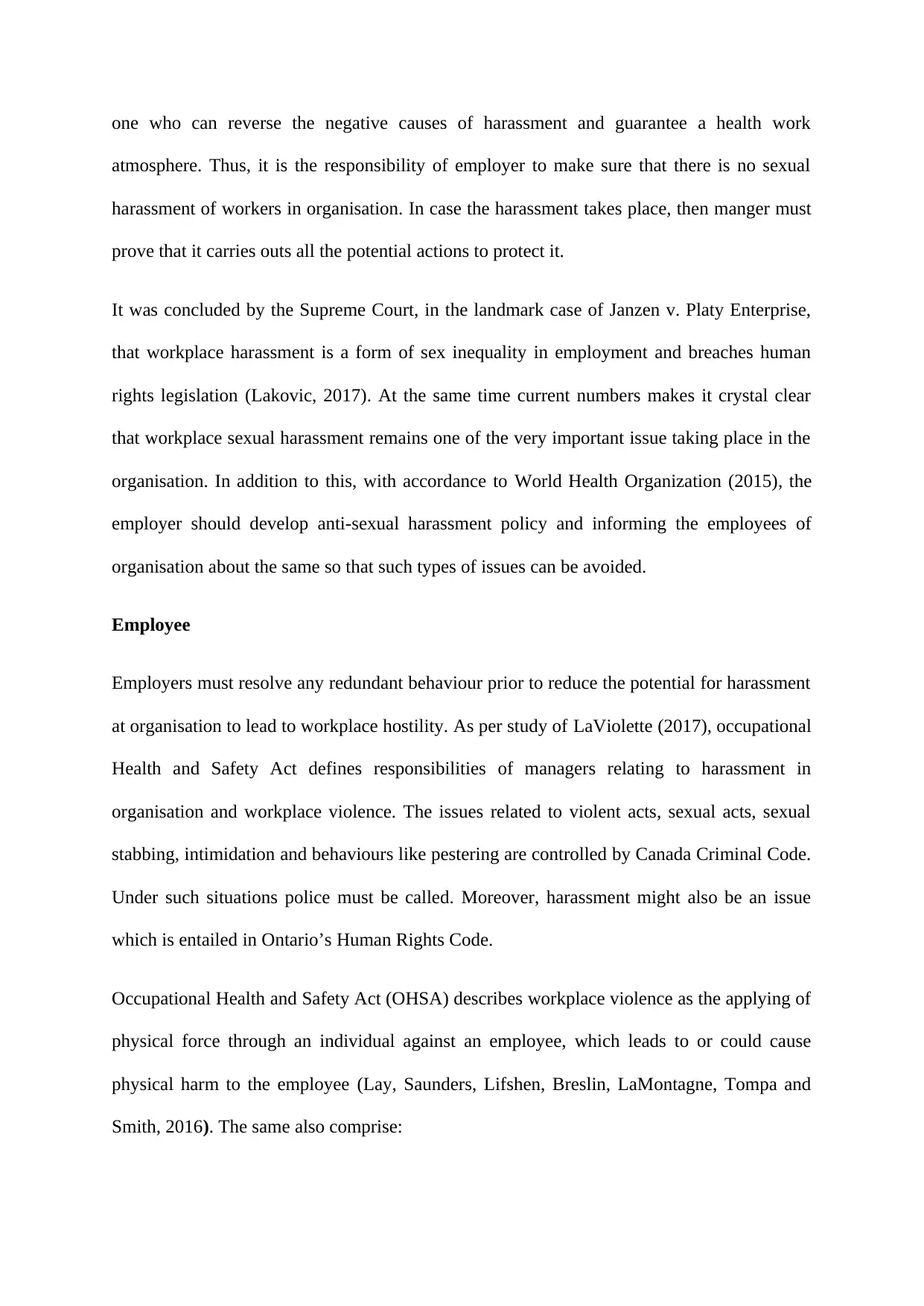
one who can reverse the negative causes of harassment and guarantee a health work
atmosphere. Thus, it is the responsibility of employer to make sure that there is no sexual
harassment of workers in organisation. In case the harassment takes place, then manger must
prove that it carries outs all the potential actions to protect it.
It was concluded by the Supreme Court, in the landmark case of Janzen v. Platy Enterprise,
that workplace harassment is a form of sex inequality in employment and breaches human
rights legislation (Lakovic, 2017). At the same time current numbers makes it crystal clear
that workplace sexual harassment remains one of the very important issue taking place in the
organisation. In addition to this, with accordance to World Health Organization (2015), the
employer should develop anti-sexual harassment policy and informing the employees of
organisation about the same so that such types of issues can be avoided.
Employee
Employers must resolve any redundant behaviour prior to reduce the potential for harassment
at organisation to lead to workplace hostility. As per study of LaViolette (2017), occupational
Health and Safety Act defines responsibilities of managers relating to harassment in
organisation and workplace violence. The issues related to violent acts, sexual acts, sexual
stabbing, intimidation and behaviours like pestering are controlled by Canada Criminal Code.
Under such situations police must be called. Moreover, harassment might also be an issue
which is entailed in Ontario’s Human Rights Code.
Occupational Health and Safety Act (OHSA) describes workplace violence as the applying of
physical force through an individual against an employee, which leads to or could cause
physical harm to the employee (Lay, Saunders, Lifshen, Breslin, LaMontagne, Tompa and
Smith, 2016). The same also comprise:
atmosphere. Thus, it is the responsibility of employer to make sure that there is no sexual
harassment of workers in organisation. In case the harassment takes place, then manger must
prove that it carries outs all the potential actions to protect it.
It was concluded by the Supreme Court, in the landmark case of Janzen v. Platy Enterprise,
that workplace harassment is a form of sex inequality in employment and breaches human
rights legislation (Lakovic, 2017). At the same time current numbers makes it crystal clear
that workplace sexual harassment remains one of the very important issue taking place in the
organisation. In addition to this, with accordance to World Health Organization (2015), the
employer should develop anti-sexual harassment policy and informing the employees of
organisation about the same so that such types of issues can be avoided.
Employee
Employers must resolve any redundant behaviour prior to reduce the potential for harassment
at organisation to lead to workplace hostility. As per study of LaViolette (2017), occupational
Health and Safety Act defines responsibilities of managers relating to harassment in
organisation and workplace violence. The issues related to violent acts, sexual acts, sexual
stabbing, intimidation and behaviours like pestering are controlled by Canada Criminal Code.
Under such situations police must be called. Moreover, harassment might also be an issue
which is entailed in Ontario’s Human Rights Code.
Occupational Health and Safety Act (OHSA) describes workplace violence as the applying of
physical force through an individual against an employee, which leads to or could cause
physical harm to the employee (Lay, Saunders, Lifshen, Breslin, LaMontagne, Tompa and
Smith, 2016). The same also comprise:
Paraphrase This Document
Need a fresh take? Get an instant paraphrase of this document with our AI Paraphraser
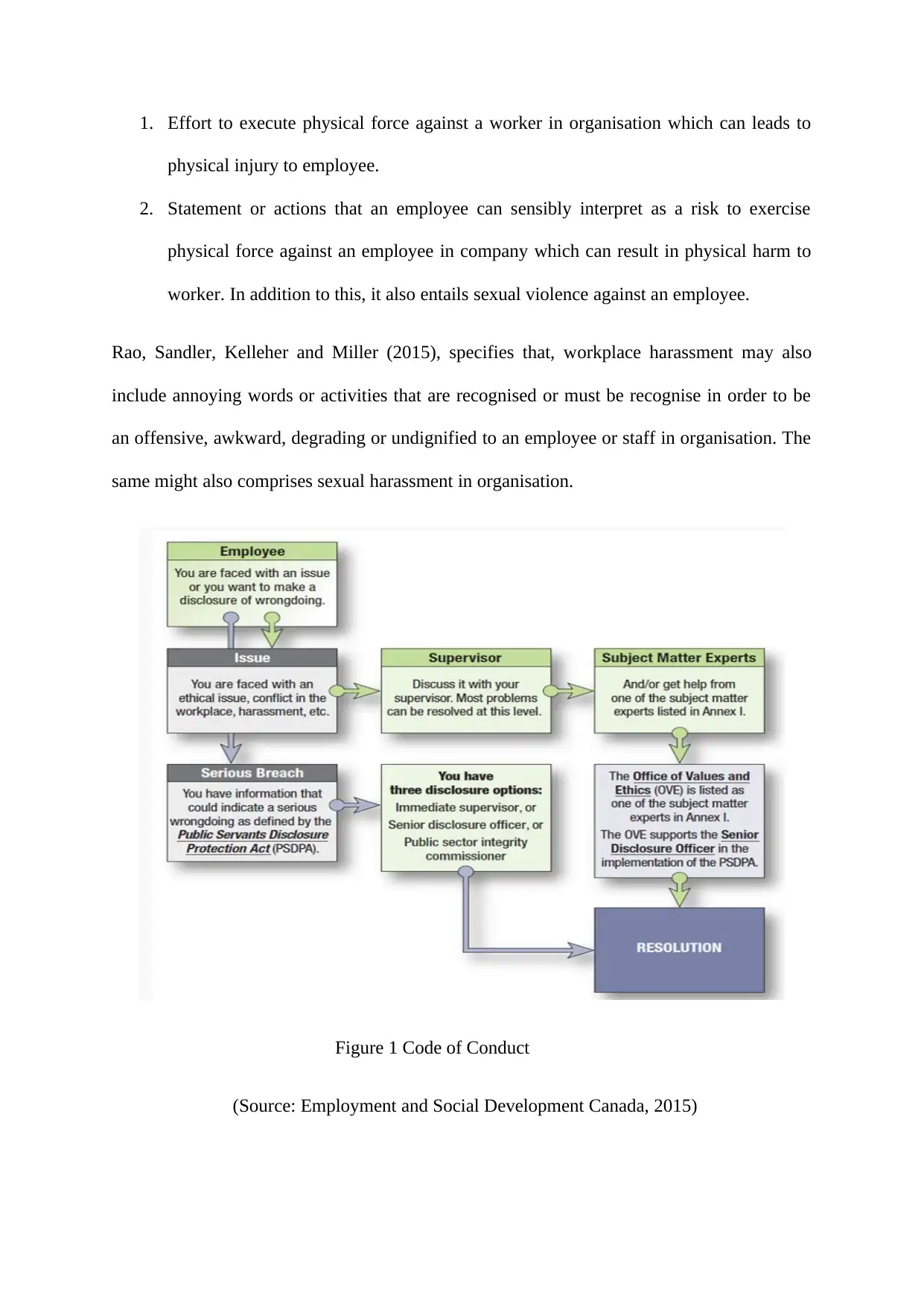
1. Effort to execute physical force against a worker in organisation which can leads to
physical injury to employee.
2. Statement or actions that an employee can sensibly interpret as a risk to exercise
physical force against an employee in company which can result in physical harm to
worker. In addition to this, it also entails sexual violence against an employee.
Rao, Sandler, Kelleher and Miller (2015), specifies that, workplace harassment may also
include annoying words or activities that are recognised or must be recognise in order to be
an offensive, awkward, degrading or undignified to an employee or staff in organisation. The
same might also comprises sexual harassment in organisation.
Figure 1 Code of Conduct
(Source: Employment and Social Development Canada, 2015)
physical injury to employee.
2. Statement or actions that an employee can sensibly interpret as a risk to exercise
physical force against an employee in company which can result in physical harm to
worker. In addition to this, it also entails sexual violence against an employee.
Rao, Sandler, Kelleher and Miller (2015), specifies that, workplace harassment may also
include annoying words or activities that are recognised or must be recognise in order to be
an offensive, awkward, degrading or undignified to an employee or staff in organisation. The
same might also comprises sexual harassment in organisation.
Figure 1 Code of Conduct
(Source: Employment and Social Development Canada, 2015)
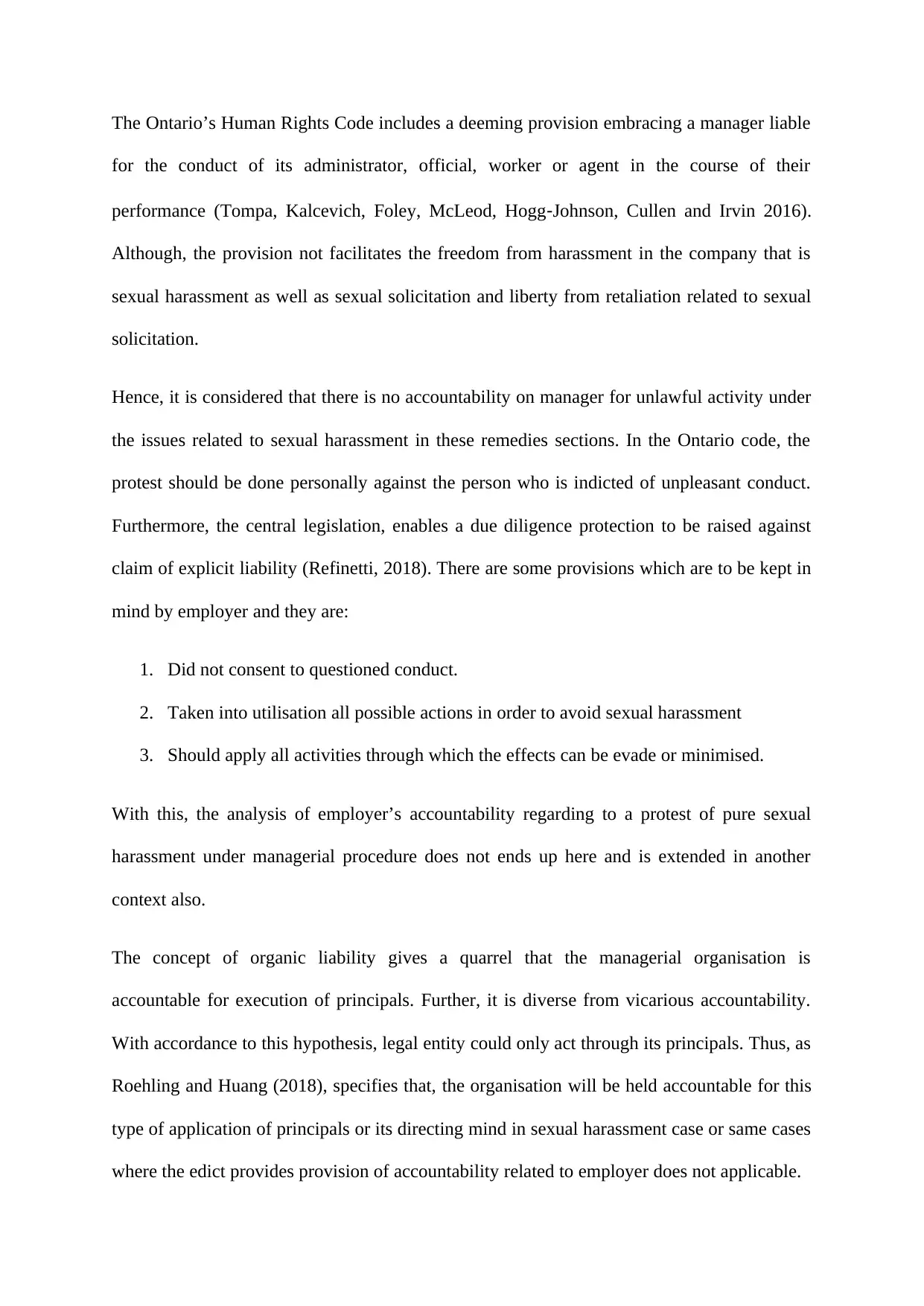
The Ontario’s Human Rights Code includes a deeming provision embracing a manager liable
for the conduct of its administrator, official, worker or agent in the course of their
performance (Tompa, Kalcevich, Foley, McLeod, Hogg‐Johnson, Cullen and Irvin 2016).
Although, the provision not facilitates the freedom from harassment in the company that is
sexual harassment as well as sexual solicitation and liberty from retaliation related to sexual
solicitation.
Hence, it is considered that there is no accountability on manager for unlawful activity under
the issues related to sexual harassment in these remedies sections. In the Ontario code, the
protest should be done personally against the person who is indicted of unpleasant conduct.
Furthermore, the central legislation, enables a due diligence protection to be raised against
claim of explicit liability (Refinetti, 2018). There are some provisions which are to be kept in
mind by employer and they are:
1. Did not consent to questioned conduct.
2. Taken into utilisation all possible actions in order to avoid sexual harassment
3. Should apply all activities through which the effects can be evade or minimised.
With this, the analysis of employer’s accountability regarding to a protest of pure sexual
harassment under managerial procedure does not ends up here and is extended in another
context also.
The concept of organic liability gives a quarrel that the managerial organisation is
accountable for execution of principals. Further, it is diverse from vicarious accountability.
With accordance to this hypothesis, legal entity could only act through its principals. Thus, as
Roehling and Huang (2018), specifies that, the organisation will be held accountable for this
type of application of principals or its directing mind in sexual harassment case or same cases
where the edict provides provision of accountability related to employer does not applicable.
for the conduct of its administrator, official, worker or agent in the course of their
performance (Tompa, Kalcevich, Foley, McLeod, Hogg‐Johnson, Cullen and Irvin 2016).
Although, the provision not facilitates the freedom from harassment in the company that is
sexual harassment as well as sexual solicitation and liberty from retaliation related to sexual
solicitation.
Hence, it is considered that there is no accountability on manager for unlawful activity under
the issues related to sexual harassment in these remedies sections. In the Ontario code, the
protest should be done personally against the person who is indicted of unpleasant conduct.
Furthermore, the central legislation, enables a due diligence protection to be raised against
claim of explicit liability (Refinetti, 2018). There are some provisions which are to be kept in
mind by employer and they are:
1. Did not consent to questioned conduct.
2. Taken into utilisation all possible actions in order to avoid sexual harassment
3. Should apply all activities through which the effects can be evade or minimised.
With this, the analysis of employer’s accountability regarding to a protest of pure sexual
harassment under managerial procedure does not ends up here and is extended in another
context also.
The concept of organic liability gives a quarrel that the managerial organisation is
accountable for execution of principals. Further, it is diverse from vicarious accountability.
With accordance to this hypothesis, legal entity could only act through its principals. Thus, as
Roehling and Huang (2018), specifies that, the organisation will be held accountable for this
type of application of principals or its directing mind in sexual harassment case or same cases
where the edict provides provision of accountability related to employer does not applicable.
⊘ This is a preview!⊘
Do you want full access?
Subscribe today to unlock all pages.

Trusted by 1+ million students worldwide
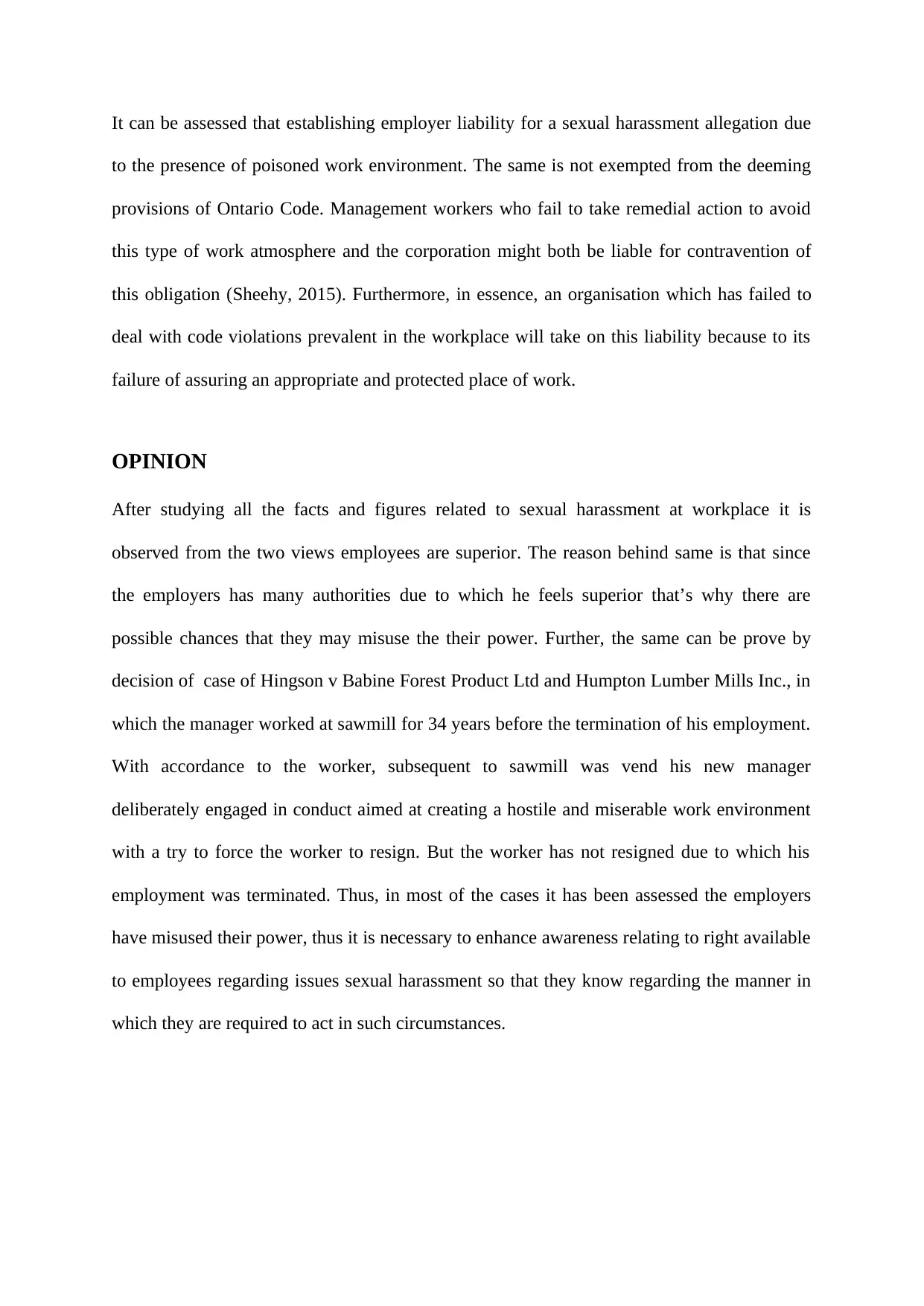
It can be assessed that establishing employer liability for a sexual harassment allegation due
to the presence of poisoned work environment. The same is not exempted from the deeming
provisions of Ontario Code. Management workers who fail to take remedial action to avoid
this type of work atmosphere and the corporation might both be liable for contravention of
this obligation (Sheehy, 2015). Furthermore, in essence, an organisation which has failed to
deal with code violations prevalent in the workplace will take on this liability because to its
failure of assuring an appropriate and protected place of work.
OPINION
After studying all the facts and figures related to sexual harassment at workplace it is
observed from the two views employees are superior. The reason behind same is that since
the employers has many authorities due to which he feels superior that’s why there are
possible chances that they may misuse the their power. Further, the same can be prove by
decision of case of Hingson v Babine Forest Product Ltd and Humpton Lumber Mills Inc., in
which the manager worked at sawmill for 34 years before the termination of his employment.
With accordance to the worker, subsequent to sawmill was vend his new manager
deliberately engaged in conduct aimed at creating a hostile and miserable work environment
with a try to force the worker to resign. But the worker has not resigned due to which his
employment was terminated. Thus, in most of the cases it has been assessed the employers
have misused their power, thus it is necessary to enhance awareness relating to right available
to employees regarding issues sexual harassment so that they know regarding the manner in
which they are required to act in such circumstances.
to the presence of poisoned work environment. The same is not exempted from the deeming
provisions of Ontario Code. Management workers who fail to take remedial action to avoid
this type of work atmosphere and the corporation might both be liable for contravention of
this obligation (Sheehy, 2015). Furthermore, in essence, an organisation which has failed to
deal with code violations prevalent in the workplace will take on this liability because to its
failure of assuring an appropriate and protected place of work.
OPINION
After studying all the facts and figures related to sexual harassment at workplace it is
observed from the two views employees are superior. The reason behind same is that since
the employers has many authorities due to which he feels superior that’s why there are
possible chances that they may misuse the their power. Further, the same can be prove by
decision of case of Hingson v Babine Forest Product Ltd and Humpton Lumber Mills Inc., in
which the manager worked at sawmill for 34 years before the termination of his employment.
With accordance to the worker, subsequent to sawmill was vend his new manager
deliberately engaged in conduct aimed at creating a hostile and miserable work environment
with a try to force the worker to resign. But the worker has not resigned due to which his
employment was terminated. Thus, in most of the cases it has been assessed the employers
have misused their power, thus it is necessary to enhance awareness relating to right available
to employees regarding issues sexual harassment so that they know regarding the manner in
which they are required to act in such circumstances.
Paraphrase This Document
Need a fresh take? Get an instant paraphrase of this document with our AI Paraphraser
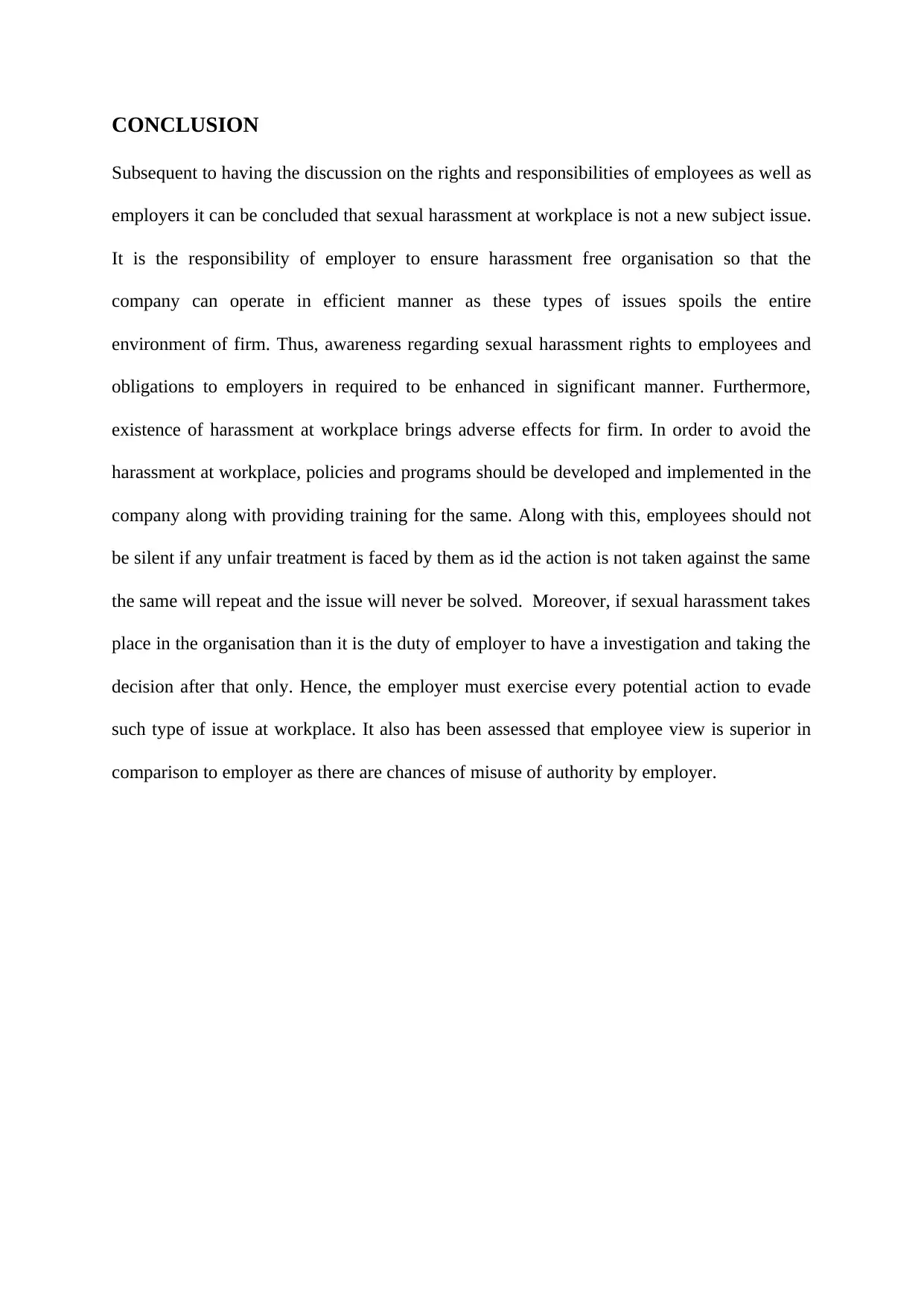
CONCLUSION
Subsequent to having the discussion on the rights and responsibilities of employees as well as
employers it can be concluded that sexual harassment at workplace is not a new subject issue.
It is the responsibility of employer to ensure harassment free organisation so that the
company can operate in efficient manner as these types of issues spoils the entire
environment of firm. Thus, awareness regarding sexual harassment rights to employees and
obligations to employers in required to be enhanced in significant manner. Furthermore,
existence of harassment at workplace brings adverse effects for firm. In order to avoid the
harassment at workplace, policies and programs should be developed and implemented in the
company along with providing training for the same. Along with this, employees should not
be silent if any unfair treatment is faced by them as id the action is not taken against the same
the same will repeat and the issue will never be solved. Moreover, if sexual harassment takes
place in the organisation than it is the duty of employer to have a investigation and taking the
decision after that only. Hence, the employer must exercise every potential action to evade
such type of issue at workplace. It also has been assessed that employee view is superior in
comparison to employer as there are chances of misuse of authority by employer.
Subsequent to having the discussion on the rights and responsibilities of employees as well as
employers it can be concluded that sexual harassment at workplace is not a new subject issue.
It is the responsibility of employer to ensure harassment free organisation so that the
company can operate in efficient manner as these types of issues spoils the entire
environment of firm. Thus, awareness regarding sexual harassment rights to employees and
obligations to employers in required to be enhanced in significant manner. Furthermore,
existence of harassment at workplace brings adverse effects for firm. In order to avoid the
harassment at workplace, policies and programs should be developed and implemented in the
company along with providing training for the same. Along with this, employees should not
be silent if any unfair treatment is faced by them as id the action is not taken against the same
the same will repeat and the issue will never be solved. Moreover, if sexual harassment takes
place in the organisation than it is the duty of employer to have a investigation and taking the
decision after that only. Hence, the employer must exercise every potential action to evade
such type of issue at workplace. It also has been assessed that employee view is superior in
comparison to employer as there are chances of misuse of authority by employer.
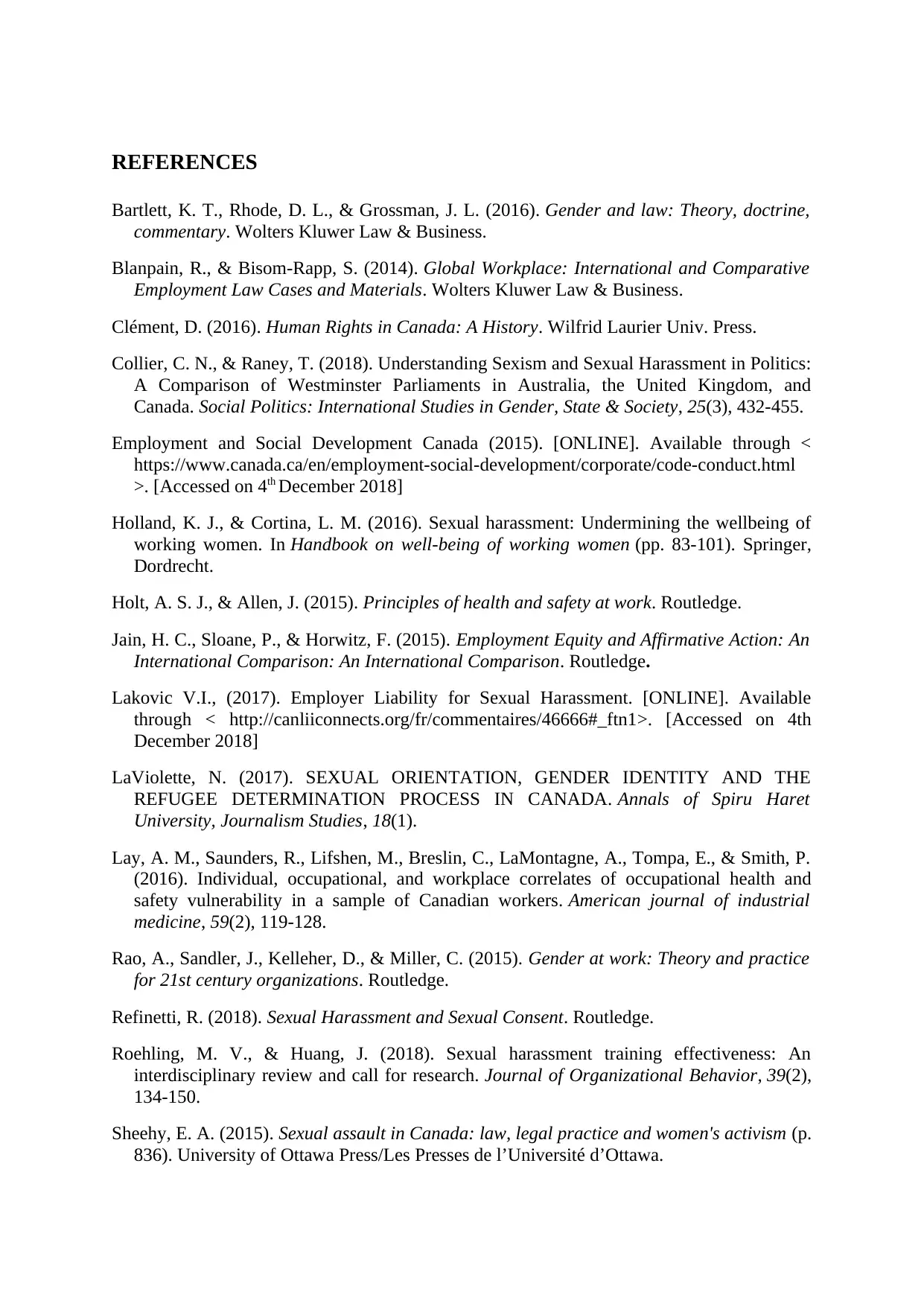
REFERENCES
Bartlett, K. T., Rhode, D. L., & Grossman, J. L. (2016). Gender and law: Theory, doctrine,
commentary. Wolters Kluwer Law & Business.
Blanpain, R., & Bisom-Rapp, S. (2014). Global Workplace: International and Comparative
Employment Law Cases and Materials. Wolters Kluwer Law & Business.
Clément, D. (2016). Human Rights in Canada: A History. Wilfrid Laurier Univ. Press.
Collier, C. N., & Raney, T. (2018). Understanding Sexism and Sexual Harassment in Politics:
A Comparison of Westminster Parliaments in Australia, the United Kingdom, and
Canada. Social Politics: International Studies in Gender, State & Society, 25(3), 432-455.
Employment and Social Development Canada (2015). [ONLINE]. Available through <
https://www.canada.ca/en/employment-social-development/corporate/code-conduct.html
>. [Accessed on 4th December 2018]
Holland, K. J., & Cortina, L. M. (2016). Sexual harassment: Undermining the wellbeing of
working women. In Handbook on well-being of working women (pp. 83-101). Springer,
Dordrecht.
Holt, A. S. J., & Allen, J. (2015). Principles of health and safety at work. Routledge.
Jain, H. C., Sloane, P., & Horwitz, F. (2015). Employment Equity and Affirmative Action: An
International Comparison: An International Comparison. Routledge.
Lakovic V.I., (2017). Employer Liability for Sexual Harassment. [ONLINE]. Available
through < http://canliiconnects.org/fr/commentaires/46666#_ftn1>. [Accessed on 4th
December 2018]
LaViolette, N. (2017). SEXUAL ORIENTATION, GENDER IDENTITY AND THE
REFUGEE DETERMINATION PROCESS IN CANADA. Annals of Spiru Haret
University, Journalism Studies, 18(1).
Lay, A. M., Saunders, R., Lifshen, M., Breslin, C., LaMontagne, A., Tompa, E., & Smith, P.
(2016). Individual, occupational, and workplace correlates of occupational health and
safety vulnerability in a sample of Canadian workers. American journal of industrial
medicine, 59(2), 119-128.
Rao, A., Sandler, J., Kelleher, D., & Miller, C. (2015). Gender at work: Theory and practice
for 21st century organizations. Routledge.
Refinetti, R. (2018). Sexual Harassment and Sexual Consent. Routledge.
Roehling, M. V., & Huang, J. (2018). Sexual harassment training effectiveness: An
interdisciplinary review and call for research. Journal of Organizational Behavior, 39(2),
134-150.
Sheehy, E. A. (2015). Sexual assault in Canada: law, legal practice and women's activism (p.
836). University of Ottawa Press/Les Presses de l’Université d’Ottawa.
Bartlett, K. T., Rhode, D. L., & Grossman, J. L. (2016). Gender and law: Theory, doctrine,
commentary. Wolters Kluwer Law & Business.
Blanpain, R., & Bisom-Rapp, S. (2014). Global Workplace: International and Comparative
Employment Law Cases and Materials. Wolters Kluwer Law & Business.
Clément, D. (2016). Human Rights in Canada: A History. Wilfrid Laurier Univ. Press.
Collier, C. N., & Raney, T. (2018). Understanding Sexism and Sexual Harassment in Politics:
A Comparison of Westminster Parliaments in Australia, the United Kingdom, and
Canada. Social Politics: International Studies in Gender, State & Society, 25(3), 432-455.
Employment and Social Development Canada (2015). [ONLINE]. Available through <
https://www.canada.ca/en/employment-social-development/corporate/code-conduct.html
>. [Accessed on 4th December 2018]
Holland, K. J., & Cortina, L. M. (2016). Sexual harassment: Undermining the wellbeing of
working women. In Handbook on well-being of working women (pp. 83-101). Springer,
Dordrecht.
Holt, A. S. J., & Allen, J. (2015). Principles of health and safety at work. Routledge.
Jain, H. C., Sloane, P., & Horwitz, F. (2015). Employment Equity and Affirmative Action: An
International Comparison: An International Comparison. Routledge.
Lakovic V.I., (2017). Employer Liability for Sexual Harassment. [ONLINE]. Available
through < http://canliiconnects.org/fr/commentaires/46666#_ftn1>. [Accessed on 4th
December 2018]
LaViolette, N. (2017). SEXUAL ORIENTATION, GENDER IDENTITY AND THE
REFUGEE DETERMINATION PROCESS IN CANADA. Annals of Spiru Haret
University, Journalism Studies, 18(1).
Lay, A. M., Saunders, R., Lifshen, M., Breslin, C., LaMontagne, A., Tompa, E., & Smith, P.
(2016). Individual, occupational, and workplace correlates of occupational health and
safety vulnerability in a sample of Canadian workers. American journal of industrial
medicine, 59(2), 119-128.
Rao, A., Sandler, J., Kelleher, D., & Miller, C. (2015). Gender at work: Theory and practice
for 21st century organizations. Routledge.
Refinetti, R. (2018). Sexual Harassment and Sexual Consent. Routledge.
Roehling, M. V., & Huang, J. (2018). Sexual harassment training effectiveness: An
interdisciplinary review and call for research. Journal of Organizational Behavior, 39(2),
134-150.
Sheehy, E. A. (2015). Sexual assault in Canada: law, legal practice and women's activism (p.
836). University of Ottawa Press/Les Presses de l’Université d’Ottawa.
⊘ This is a preview!⊘
Do you want full access?
Subscribe today to unlock all pages.

Trusted by 1+ million students worldwide
1 out of 13
Related Documents
Your All-in-One AI-Powered Toolkit for Academic Success.
+13062052269
info@desklib.com
Available 24*7 on WhatsApp / Email
![[object Object]](/_next/static/media/star-bottom.7253800d.svg)
Unlock your academic potential
Copyright © 2020–2025 A2Z Services. All Rights Reserved. Developed and managed by ZUCOL.





